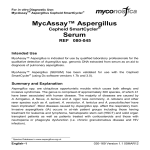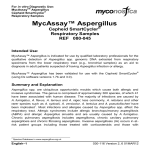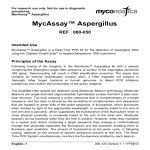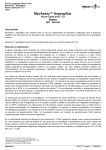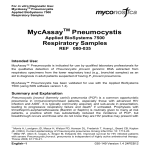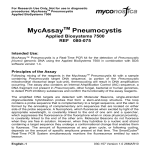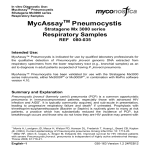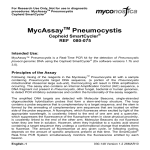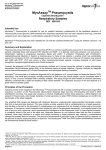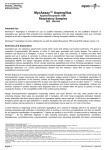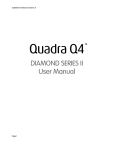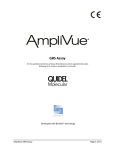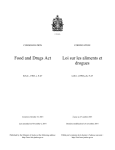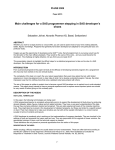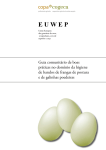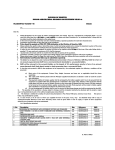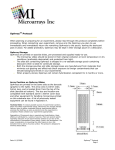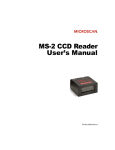Download Serum - Myconostica
Transcript
For in vitro Diagnostic Use: MycAssayTM Aspergillus Roche LightCycler® 2.0 Serum MycAssay™ Aspergillus Roche LightCycler® 2.0 Serum REF 080-045 Intended Use: MycAssay™ Aspergillus is indicated for use by qualified laboratory professionals for the qualitative detection of Aspergillus spp. genomic DNA extracted from serum as an aid to diagnosis of invasive aspergillosis. MycAssay™ Aspergillus (Serum) has been validated for use with the Roche LightCycler® 2.0. Summary and Explanation Aspergillus spp. are ubiquitous opportunistic moulds which cause both allergic and invasive syndromes. The genus is comprised of approximately 300 species, of which 41 have been associated with human disease. The majority of diseases are caused by A. fumigatus, A. flavus, A. terreus and A. niger; less commonly, A. nidulans and other rarer species such as A. sydowii, A. versicolor, A. lentulus and A. pseudofischeri have been implicated1. Most diseases caused by Aspergillus spp. affect the respiratory tract. Invasive aspergillosis (IA) occurs in at-risk patient groups including those having treatment for leukaemia and lymphoma, haematopoetic stem cell (HSCT) and solid organ transplant patients as well as patients treated with corticosteroids and those with neutropenia or phagocyte dysfunction (i.e. chronic granulomatous disease and HIV infection). Invasive fungal disease (IFD) rates are nearly seven times higher in allogeneic HSCT patients than in autologous transplant patients, and invasive aspergillosis (IA) is 1 Species Database in www.aspergillus.org.uk English–1 030-177 Version 1.1 05MAR12 MycAssayTM Aspergillus For in vitro Diagnostic Use Roche LightCycler® 2.0 Serum responsible for approximately half of infections2. Aspergillosis is largely confined to the early post transplant neutropenic phase in autologous HSCT patients. Allogeneic HSCT patients are at risk for much longer periods not only up to but also beyond 100 days, owing to their more frequent GvHD and slow T cell recovery. In patients receiving chemotherapy for acute leukaemia or salvage regimens for relapsed leukaemia or lymphoma, IA is a leading cause of death. Consensus definitions of Invasive Fungal Diseases have been revised and published by the European Organisation for Research Treatment Centre (EORTC) and the Mycoses Study Group (MSG) including defined criteria for diagnosis of proven, probable and possible IA in patients with haematologic malignancy or following HSCT3. Currently, the criteria for ‘probable IA’ are defined as one host factor plus one clinical criterion plus one microbiological test. Diagnosis of ‘possible IA’ does not require a microbiology criterion. The microbiological tests accepted in the probable IA criteria include a serum based ELISA test that detects the presence of galactomannan (GM). Two consecutive positive GM tests are recommended to improve diagnostic accuracy. A meta analysis by Mengoli et al reported on >10,000 blood, serum and plasma samples from 1618 patients at risk for IA. They calculated the sensitivity and specificity of a single PCR positive blood sample to be 88% (95% C.I. 75% - 94%) and 75% (95% C.I. 63% – 84%) respectively and the diagnostic odds ratio for proven and probable cases to be 16.41 (95% C.I. 6.43 – 41.88)4. MycAssay™ Aspergillus is a molecular diagnostic kit for the detection of Aspergillus spp. genomic DNA using Molecular Beacon5 Real-Time PCR technology. The whole test procedure, including extraction of DNA from the clinical sample, can be completed in approximately 2½ hours, compared to fungal culture which can take several days to produce positive results. This assay offers advantages over currently available diagnostic methods for acute invasive and chronic pulmonary aspergillosis. These advantages include faster detection of Aspergillus spp. and the potential for increased sensitivity for 2 3 4 5 Kontoyiannis DP et al Clin Infect Dis 2010: 50(8); 1091-1100 Ascioglu S et al Clin Infect Dis 2002: 34; 7-14 Mengoli C. et al The Lancet ID 2009: 9; 86-96 Tyagi S, Kramer FR. (1996). Molecular beacons: Probes that fluoresce upon hybridization. Nature Biotechnology: 14: 303-308. 030-177 Version 1.1 05MAR12 English–2 For in vitro Diagnostic Use MycAssayTM Aspergillus Serum Roche LightCycler® 2.0 Aspergillus spp. in highly immunocompromised patients suspected of having invasive aspergillosis. Principles of the Procedure Following mixing of the reagents in the MycAssay™ Aspergillus kit with a sample containing the Aspergillus target DNA sequence (a section of the Aspergillus ribosomal 18S gene), thermocycling will result in DNA amplification occurring. The assay also contains an Internal Amplification Control (IAC), a DNA fragment not present in Aspergilli, other fungal, bacterial or human genomes, to detect PCR inhibitory substances and confirm the functionality of the assay reagents. The amplified DNA targets are detected using Molecular Beacon technology. Molecular Beacons are single-stranded oligonucleotide hybridisation probes that form a stem-andloop structure. The loop contains a probe sequence that is complementary to a target sequence, and the stem is formed by the annealing of complementary arm sequences that are located on either side of the probe sequence. A fluorophore, which fluoresces when excited by light of the appropriate wavelength, is covalently linked to the end of one arm and a quencher, which suppresses the fluorescence of the fluorophore when in close physical proximity, is covalently linked to the end of the other arm. Molecular Beacons do not fluoresce when they are free in solution. However, when they hybridise to a nucleic acid strand containing a target sequence they undergo a conformational change that physically separates the fluorophore and the quencher enabling them to fluoresce upon excitation. The amount of fluorescence at any given cycle, or following cycling, depends on the amount of specific amplicons present at that time. The RealTime PCR System simultaneously monitors the fluorescence emitted by beacons. English–3 030-177 Version 1.1 05MAR12 MycAssayTM Aspergillus Roche LightCycler® 2.0 For in vitro Diagnostic Use Serum Precautions The kit is intended for use only by laboratory professionals. Procedures are required for non-aerosol manipulations of specimens. Standard precautions and institutional guidelines should be followed in handling all samples. A Material Safety Data Sheet is available from Myconostica Ltd. This assay is for in vitro diagnostic use only. In analytical validation studies, levels of transaminase of 22.2 U per 0.5 mL serum were shown to have a possible degradation effect on Aspergillus DNA. This assay has been evaluated with serum collected in Greiner Red Top serum collection tubes. Other serum/blood collection tubes may contain inhibiting or competing substances that have not been tested. This assay has been validated for serum specimens. Validation data are not available for plasma or whole blood. This assay is for use with the Roche LightCycler® 2.0 and LightCycler® v4.1 software only. Do not use reagents or controls if the protective pouches are open or broken when received. Reagents and controls are not interchangeable between kits with different Lot numbers. Never pool reagents or controls from different tubes even if they are from the same Lot. Never use the reagents or controls after their expiry date. Reagents and controls should not be re-frozen or re-used after opening. Wear protective clothing and disposable gloves while handling kit reagents. Ensure all reagents not provided are free from fungal contamination. To avoid contamination with Aspergillus or IAC amplicons, do not open the reaction tubes after amplification. Avoid microbial and deoxyribonuclease (DNAse) contamination of reagents when removing aliquots from tubes. The use of sterile, DNAse-free, low-retention disposable filter-tips or positive displacement pipette tips is recommended. Use a new tip for each specimen or reagent. Dispose of unused reagents and waste in accordance with country, federal, state and local regulations. Additional controls may be tested according to guidelines or regulations of local, state, provincial, federal or accrediting organisations. 030-177 Version 1.1 05MAR12 English–4 For in vitro Diagnostic Use MycAssayTM Aspergillus Serum Roche LightCycler® 2.0 Do not eat, drink or smoke in areas where specimens or kit reagents are being handled. Serum may be stored up to 48h in a refrigerator (2-8ºC) or freezer (-15 to -25ºC). Low concentrations of DNA can be unstable if not stored correctly. It is recommended that DNA extractions from clinical samples are stored at -80oC to preserve their integrity. Multiple rounds of thawing and refreezing should also be avoided whenever possible. Kit Contents Description The kit consists of five 3-compartment sealed foil pouches each of which can be removed from the box and used separately. Each pouch contains sufficient reagents for 8 reactions. Volume 66 µL Tube 1 (Orange Cap) dNTPs MgCl2 Buffered solution of DNA Polymerase complex Tube 2 (Green Cap) <0.01% Primers <0.01% Molecular Beacons <0.0001% Internal Amplification Control (IAC) The Internal Amplification Control is a recombinant DNA plasmid containing a non-infective sequence unrelated to target (Aspergillus) sequence Tris-HCl Buffer 66 µL Tube 3 (Clear Cap) Negative Control Water 25 µL Tube 4 (Black Cap) Positive Control <0.0001% Positive Control DNA The Positive Control molecule is a recombinant plasmid containing the Aspergillus target sequence Tris-HCl Buffer 25 µL English–5 030-177 Version 1.1 05MAR12 MycAssayTM Aspergillus Roche LightCycler® 2.0 For in vitro Diagnostic Use Serum The kit also contains: MycAssay™ Aspergillus Myconostica Protocol CD-ROM Instructions for Use Certificate of Analysis Storage The kit should be stored frozen (-15 to -25 °C) until the expiry date indicated on the kit box label, when it should be disposed of according to local regulations. Once a pouch has been opened, the contents must be used immediately, not re-frozen or re-used at a later date. Equipment/Materials required but not provided Roche LightCycler® 2.0 Real-Time PCR system (including User Manual, attached computer and LightCycler® Software v4.1) LightCycler® 2.0 carousel centrifuge (optionally capillary adaptors for mini centrifuge) Sample carousel for 20 µL capillaries LightCycler® 2.0 20 µL capillaries with caps Capillary rack holder Capillary releaser Capping tool Micro centrifuge Vortex mixer Micropipettes (volumes required 7.5 µL – 20 µL) Sterile low-retention filtertips Disposable gloves, powderless Proprietary DNA decontaminating solution DNA isolation kit (see below) MycAssayTM CC-kit (see below) 030-177 Version 1.1 05MAR12 English–6 MycAssayTM Aspergillus Roche LightCycler® 2.0 For in vitro Diagnostic Use Serum Specimen The specimen for the MycAssay™ Aspergillus assay is total genomic DNA extracted from serum samples. The following DNA extraction kit and equipment, used during validation, is recommended for this purpose: - High Pure PCR Template Preparation kit (Roche Diagnostics Cat. No. 11 796 828 001) Proteinase K solution (Sigma Aldrich Chemicals Cat. No. P4850-5ML) 2-Propanol (Sigma Aldrich Chemicals Cat.No. 19516-25ML) Vortex-Genie 2 (Scientific Industries Inc., New York, USA) MycAssay™ Colour Compensation (CC) kit Accurate analysis of data produced using MycAssay™ Aspergillus assay requires the application of a colour compensation file produced using the Myconostica MycAssayTM CC kit. Once created, the file can be applied to multiple runs on the same machine. Please contact your local distributer for details. Procedural Notes Read the entire protocol before commencing. The entire MycAssay™ Aspergillus process (including DNA extraction) takes approximately 2½ hours, dependent on the number of samples tested. Setting up of the test should be performed in a PCR workstation or pre-PCR laboratory. If a PCR workstation is not available, then the test should be set-up in a dedicated area of the laboratory7, separated from areas used for DNA extractions, that is regularly cleaned with DNA decontaminating reagents. However, avoid using DNA decontaminating reagents when performing the RealTime PCR set-up as they can inhibit the assay. Use micropipettes for the transfer of fluids. Dedicated micropipettes should be used for the set-up of these reactions and they should be regularly decontaminated. Low-retention filtertips are recommended for use to ensure that no DNA is lost during the set-up procedure. 7 For example see Mifflin, T. E. (2003). Setting up a PCR Laboratory. In PCR Primer, 2nd Ed. (eds. Dieffenbach and Dveksler). Cold Spring Harbour Laboratory Press, Cold Spring Harbour, NY. USA. English–7 030-177 Version 1.1 05MAR12 MycAssayTM Aspergillus Roche LightCycler® 2.0 For in vitro Diagnostic Use Serum Exercise caution when handling Tube 4. This contains positive control DNA material and contamination could cause false positive test results. Wear gloves at all times. All reagent tubes must be capped following use and prior to disposal. Accurately record the positions of all the capillaries (within the 32-position carousel) with their corresponding sample ID’s on the experimental plan. Accurate analysis of the data requires the application of a colour compensation file created using the Myconostica MycAssayTM CC kit. Procedure for Use: The procedure has 2 stages; DNA extraction from serum, followed by Real-Time PCR. DNA extraction is achieved using the High Pure PCR Template Preparation Kit (High Pure kit). The High Pure Kit is designed to purify nucleic acids from a variety of sample types. The extraction protocol, detailed in this IFU, has been optimised to isolate Aspergillus.spp DNA from serum and is suitable for use with the MycAssayTM Aspergillus Serum kit. IMPORTANT NOTE: The manufacturer’s instructions have been modified to improve the yield of DNA recovered from a serum sample and to improve the sensitivity of the test. Certain reagents detailed in steps 1 and 2 of Section 2.3 in the High Pure Kit IFU, will be depleted before others, and will need to be replaced. During the validation process, Proteinase K from Sigma Aldrich was used. 030-177 Version 1.1 05MAR12 English–8 MycAssayTM Aspergillus Roche LightCycler® 2.0 For in vitro Diagnostic Use Serum Extraction Protocol – shaded areas identify those steps that are modified from manufacturer’s instructions. Add 400 µL of Binding buffer and 80 µL of Proteinase K, mix immediately, incubate for 10 minutes at 70˚C 0.5 mL serum Add 200 µL of Isopropanol, mix well and apply to High Pure filter tube (by repeat addition), centrifuge for 1 min at 8,000xg Discard flow through and collection tube Discard flow through and collection tube Discard flow through and collection tube Discard flow through, retain collection tube Discard collection tube tube Centrifuge for 1 minute at 8,000xg Add 500 µL Inhibitor Removal Buffer Add 500 µL Wash Buffer Centrifuge for 1 minute at 8,000xg Centrifuge for 1 minute at 8,000xg Add 500 µL Wash Buffer Centrifuge for 1 minute at 10,000xg Centrifuge for 1 minute at 8,000xg Add new sterile 1.5 mL tube and 65 µL Elution Buffer (70˚C) Purified DNA English–9 030-177 Version 1.1 05MAR12 MycAssayTM Aspergillus Roche LightCycler® 2.0 For in vitro Diagnostic Use Serum 1. Real-Time PCR Set-Up 1.1 To begin, switch on the LightCycler® 2.0 Real-Time PCR System (instrument, associated computer and centrifuge) and launch the relevant software. Enter username and password as required and choose the Diagnostic database. If this is the first run of a day, perform an instrument Self-Test first before starting a run. Remember: a colour compensation run must be completed prior to analysing results for MycAssayTM Aspergillus on the LightCycler® 2.0. However, this does not have to be performed prior to using this product, and can be carried out and applied to this run file later. Ensure the work area has been cleaned using DNA decontaminating reagents and allowed to dry completely; avoid use during assay set-up as excess cleaning solution may inhibit the PCR. A pouch contains one each of Tube 1, Tube 2, Tube 3 and Tube 4. There are sufficient reagents in one pouch to run 8 reactions. At least one positive control and one negative control reaction must be performed per run where the reagents are from a single kit Lot. One pouch therefore can analyse 6 patient samples. If more than 6 samples need to be tested, more than one pouch can be used if the pouches used are from the same kit. However, the LightCycler® 2.0 can only hold up to 32 samples in a single run. Therefore, a maximum of 30 patient samples can be performed in a single run (4 pouches). Calculate the number of reactions required, referring to the table below: 1.2 1.3 1.4 1.5 Number of Pouches 1.6 Maximum number of patient samples 1 6 2 14 3 22 4 30 Remove the appropriate number of pouches from the freezer. Do not use any pouch that is no longer sealed. If the patient samples were frozen after extraction, also remove these from the freezer. 030-177 Version 1.1 05MAR12 English–10 MycAssayTM Aspergillus Roche LightCycler® 2.0 For in vitro Diagnostic Use Serum 1.7 1.8 1.9 1.10 1.11 Tear open the required number of pouches and remove the tubes. If more than one pouch is being used, but only one set of positive and negative controls are being run, it is only necessary to remove Tubes 3 and 4 from one pouch. Exercise caution when handling Tube 4. This contains positive control DNA material and contamination could cause false positive patient results. Allow the contents of the tubes to thaw by placing on the laboratory bench for 5-10 minutes, ensuring that the contents of each tube are completely thawed before proceeding. Vortex mix the contents of the tubes and the patient samples; follow by a short spin in a microcentrifuge to ensure collection of all the contents at the base of the tubes before use. Place the required number of 20 µL capillaries in a capillary rack holder. Take care not to leave any marks on the glass. Always set up the negative control first, followed by the patient samples. The positive control should always be set up last. Reagent and DNA volumes are shown in the table below: Reaction Reagent Negative control Patient samples Positive control Tube 1 (Orange cap) 7.5 µL 7.5 µL 7.5 µL Tube 2 (Green cap) 7.5 µL 7.5 µL 7.5 µL Tube 3 (Clear cap) 10 µL - - Patient Samples - 10 µL - Tube 4 (Black cap) - - 10 µL 25 µL 25 µL 25 µL Total volume 1.12 Add reagents in the order shown in the table above; Tube 1, then Tube 2, followed by the template (Negative control, Patient sample, or Positive control). Take care when taking aliquots from Tube 1; the liquid is viscous and can stick on the inner ridge of the tube. If this happens, re-spin to collect the final contents in the base of the tube before attempting to remove the final aliquots. English–11 030-177 Version 1.1 05MAR12 MycAssayTM Aspergillus Roche LightCycler® 2.0 1.13 1.14 1.15 1.16 1.17 1.18 1.19 1.20 For in vitro Diagnostic Use Serum Use a new pipette tip for every liquid transfer. Re-cap each reagent tube after use and immediately discard it, and any remaining contents, into a sealable clinical waste container. Unused reagents cannot be saved for later use. Take extra care when pipetting Tube 4 (positive control DNA) to ensure it does not contaminate any other reaction. Capping all the other capillaries before opening Tube 4 can reduce the risk of cross-contamination. Carefully cap the capillaries with the caps provided in the capillary box using a capping tool. Ensure the capillaries are firmly capped. Capillaries can be capped once the template has been added to the reaction if desired to reduce the potential for cross/environmental-contamination. If the LightCycler® 2.0 carousel centrifuge is not available, spin the samples down in a mini centrifuge using the capillary adapters provided with the capillary rack holder. Otherwise, proceed to 1.17. Very carefully, transfer all the capillaries to the sample carousel in exactly the same order that they are in the capillary rack holder starting with the first capillary in the position 1 and continue in the ascending order leaving no gaps. Push each capillary all the way down till it firmly rests in its place. If not already spun down in 1.16, spin the samples using the LightCycler® 2.0 carousel centrifuge. Proceed to Section 2 promptly. MycAssayTM Aspergillus reactions are stable on the bench for up to 60 minutes. Following the PCR set-up ensure the work area is thoroughly cleaned using DNA decontaminating reagents. 030-177 Version 1.1 05MAR12 English–12 For in vitro Diagnostic Use Serum 2. Performing the run 2.1 2.2 MycAssayTM Aspergillus Roche LightCycler® 2.0 Insert the MycAssayTM Aspergillus Myconostica Protocol CD-ROM. Go to File, select Import, and select Object .ixo files. Import the Macro MAA SERUM v1.ixo file from the CD to your database. English–13 030-177 Version 1.1 05MAR12 MycAssayTM Aspergillus For in vitro Diagnostic Use Roche LightCycler® 2.0 Serum 2.3 Go to File, select Save and save the macro in the desired location in your database. 2.4 Select the Run Macro option from the Toolbar. 2.5 2.6 Select the Macro MAA SERUM v1.ixo template file and press Open. Follow the wizard instructions. Tick the Perform Self-Test box if this is first run if a day. 030-177 Version 1.1 05MAR12 English–14 For in vitro Diagnostic Use Serum 2.7 2.8 MycAssayTM Aspergillus Roche LightCycler® 2.0 Name and save the run file in a desired location. Go to the Samples section by clicking the tab in the left of the screen. Edit sample number in the Samples Count box and names in the Capillary view tab. Name the samples as it states in your experimental plan according to their position in the sample carousel. English–15 030-177 Version 1.1 05MAR12 MycAssayTM Aspergillus Roche LightCycler® 2.0 For in vitro Diagnostic Use Serum 2.9 Place the spun down sample carousel in the LightCycler® 2.0 instrument. Ensure that the notch below sample position 1 on the carousel locks into position with the pin on the thermal chamber. Make sure that the carousel is inserted firmly in the chamber and close the lid. 2.10 When finished, press the Start Run button. Make sure that the instrument has found all the capillaries in the carousel and the program has started. 030-177 Version 1.1 05MAR12 English–16 For in vitro Diagnostic Use Serum MycAssayTM Aspergillus Roche LightCycler® 2.0 3. Data Analysis and Interpretation 3.1 Remember: a colour compensation object must be applied prior to analysing results for MycAssayTM Aspergillus on the LightCycler® 2.0. If you have not yet created one, please do so now before continuing with Data Analysis and Interpretation. When the run has finished check for the contents of the popped up report and print it if desired. The Aspergillus results can be viewed in the ASP (530) analysis section and the IAC results in the IAC (560) analysis section. 3.2 3.3 In both sections, ASP (530) and IAC (560), select the correct Colour Compensation file (MycAssay CC file) to be applied to the experiment. English–17 030-177 Version 1.1 05MAR12 MycAssayTM Aspergillus For in vitro Diagnostic Use Roche LightCycler® 2.0 Serum 3.4 Analyse each sample starting with the controls, as shown in the flowchart below (details can also be found in the table shown beneath the flowchart). Check the Negative Control NO Is the ASP Cp 38.0 or recorded as No Cp? Run is contaminated ACTION: Repeat the run YES Check the Negative Control NO Is the IAC Cp 30.3-33.9? Run failure ACTION: Repeat the run Run failure YES Check the Positive Control NO ACTION: Repeat the run Is the ASP Cp 15.0-20.0? YES Positive for Aspergillus DNA YES Check the test Sample Is the ASP Cp < 38.0 NO Negative for Aspergillus DNA YES Check the test Sample Is the IAC Cp 30.3-33.9? NO IAC failure ACTION: Repeat sample. If the same result again; suspect inhibitor present in sample 030-177 Version 1.1 05MAR12 English–18 MycAssayTM Aspergillus Roche LightCycler® 2.0 For in vitro Diagnostic Use Serum Sample Pathogen (530) Cp IAC (560) Cp Interpretation Further Action Negative Control 38.0 or No Cp Within 30.333.9 Negative Control acceptable Patient results are valid Negative Control 38.0 or No Cp <30.3 or >33.9 Failure in Negative Control Repeat entire run Negative Control <38.0 Within 30.333.9 Contamination Repeat entire run Positive Control Within 15.0-20.0 N/A Positive Control acceptable Patient results are valid Positive Control <15.0 or >20.0 N/A Failure in Positive Control Repeat entire run Patient Sample ≥38.0 or No Cp Within 30.333.9 Negative for Aspergillus Report result: Outcome 1 Patient Sample <38.0 N/A Positive for Aspergillus Report result: Outcome 2 Patient Sample < 38.0 or No Cp <30.3 or >33.9 IAC failure in sample Repeat sample: Outcome 3 See Clinical Reporting (Outcome 1, 2 or 3) 4. Troubleshooting 4.1 The Negative Control has generated a positive signal in the ASP (530) channel: Contamination occurred during the set up. Results from the entire run cannot be relied upon as accurate. Repeat the entire run taking great care when adding the templates, in particular, the Positive Control (Tube 4), to ensure that cross-contamination does not occur. Make sure that the work area and instruments are properly decontaminated before and after use. The Negative Control was incorrectly positioned in the instrument. Take care that the capillaries are annotated correctly within the software. English–19 030-177 Version 1.1 05MAR12 MycAssayTM Aspergillus Roche LightCycler® 2.0 For in vitro Diagnostic Use Serum 4.2 The Negative Control IAC Cp value is not within the acceptable range: The PCR has been inhibited. Ensure that the work area and instruments are thoroughly dry after the use of decontaminating agents prior to PCR set up. The storage conditions of the kit did not comply with the instructions in the Storage section of this IFU, or the kit has expired. Please check correct storage conditions of the kit have been followed. Check the expiry date of the reagents (see the kit box / pouch label) and repeat with unexpired kit if necessary. Either Tube 1 or 2 reagent was not added to the PCR, or double the amount of Tube 2 was added. Repeat the run taking care in the set-up stage. Such errors can be detected by seeing higher or lower levels of liquid in one reaction capillary compared to others. The correct CC-file was not applied to the data. Create a CC-file using the Myconostica MycAssayTM CC kit and apply to the results and reanalyse. See your local distributer for details of this kit. 4.3 The Positive Control is negative: The storage conditions of the kit did not comply with the instructions in the Storage section of this IFU, or the kit has expired. Please check correct storage conditions of the kit have been followed. Check the expiry date of the reagents (see the kit box / pouch label) and repeat with an unexpired kit if necessary. An error occurred during step 1.11/1.13 and the Positive Control template (Tube 4) was placed in the wrong reaction tube. Repeat the run, taking great care during the set-up stage. Such errors can be detected by seeing a higher level of liquid in one reaction, and a lower level in another, compared to normal. Either Tube 1 or 2 reagent was not added to the reaction. 030-177 Version 1.1 05MAR12 English–20 For in vitro Diagnostic Use MycAssayTM Aspergillus Serum Roche LightCycler® 2.0 Repeat the run taking care in the set-up stage. Such errors can be detected by seeing lower levels of liquid in this reaction capillary compared to others. The Positive Control was incorrectly positioned in the instrument. Take care that the capillaries are annotated correctly within the software. 4.4 Patient sample(s) are negative and the IAC is out of range (Outcome 3): It is likely that the patient sample(s) contain PCR inhibitors. We recommend that DNA from samples is extracted using the High Pure kit following the modified procedure in Procedures for Use, and not manufacturer’s instructions, for optimal DNA extraction. Some collection tubes for serum may contain PCR inhibitors that have not been tested. 4.5 The Patient Sample is negative in the ASP (530) section and the IAC (560) plot drifts away significantly from the regular baseline (as shown on the example picture below; arrows indicate abnormal plots): The PCR reaction was inhibited. English–21 030-177 Version 1.1 05MAR12 MycAssayTM Aspergillus For in vitro Diagnostic Use Roche LightCycler® 2.0 Serum Ensure that the work area and instruments are thoroughly dry after the use of decontaminating agents prior to PCR set up. Run the patient sample again. If the problem repeats, the PCR inhibitor is present in the sample. Report the sample as Undetermined (Outcome 3). 4.6 The results in the IAC (560) section almost exactly match the results in the ASP (530) section. No Colour Compensation file or an incorrect Colour Compensation file was applied to the experiment results. In both analysis sections check if the Colour Compensation is ON and that the same MycAssayTM CC file is applied in both channels. 4.7 The baseline for some samples match the Negative control, indicating no amplification has occurred. However, the software has reported out a positive Cp value (as in figure below): An output of a positive Cp for a negative amplification plot was seen only twice in 154 negative reactions performed during validation studies. If this happens, please repeat the sample/s to confirm a Negative result. 030-177 Version 1.1 05MAR12 English–22 For in vitro Diagnostic Use MycAssayTM Aspergillus Serum Roche LightCycler® 2.0 4.8 When I apply my CC object some of the data in the 560 IAC channel dips, resulting in Cp values which are outside the acceptable range: This is entirely normal for reactions containing high concentrations of target DNA and will not interfere in the interpretation of patient results. Follow the normal analysis; you will see that for samples which are positive for Aspergillus, the IAC result is not required for an outcome decision to be made for the patient. 4.9 There are no results for any channel with any samples or controls: The storage conditions of the kit did not comply with the instructions in the Storage section of this IFU, or the kit has expired. Please check correct storage conditions of the kit have been followed. Check the expiry date of the reagents (see the kit box / pouch label) and repeat with an unexpired kit if necessary. The equipment used is not functioning optimally. Please check that your Real-Time PCR instrument has an up-to-date service history and has been fully calibrated as described in its Installation and Maintenance Guide. An incorrect protocol file was used during the software set up. Please refer to Section 2 and choose the correct Protocol file, as specified for each software type/version, from the Myconostica Protocol CD-ROM. Only English–23 030-177 Version 1.1 05MAR12 MycAssayTM Aspergillus For in vitro Diagnostic Use Roche LightCycler® 2.0 Serum the file appropriate to the software can be loaded. Repeat the run using the correct protocol file. If you have further questions, or you experience any problems, please contact Technical Support ([email protected]) 030-177 Version 1.1 05MAR12 English–24 MycAssayTM Aspergillus Roche LightCycler® 2.0 For in vitro Diagnostic Use Serum Performance Characteristics and Limitations The kit was initially validated for use with serum using the Cepheid SmartCycler®. Analytical sensitivity (Limit of Blank) was established on the LightCycler® 2.0 platform, using 20 µL glass capillaries (Roche Cat # 04929292001 or 11909339001), and is reported below. Where the differences between platforms were not expected to affect the performance of the assay, and therefore the performance claim, the other studies were not repeated. These results, obtained using the SmartCycler®, are considered transferable to the LightCycler® 2.0 platform. Analytical Sensitivity Using the LightCycler® 2.0 protocol described above, and PCR templates generated at Myconostica, the LoB for the MycAssay™ Aspergillus was determined to be a Cp of 38.0. The following Performance Claims were established for serum using the ® Cepheid SmartCycler Analytical Selectivity Analytical selectivity was tested using DNA extracted from a variety of different fungal and non-fungal species. The following species were tested during the initial validation for respiratory samples and did not report out a positive result; Alternaria alternata Blastomyces capitatus, Candida albicans, C. glabrata, C. parapsilosis, C. tropicalis, Cladosporium spp., Cryptococcus neoformans, Doratomyces microsporus, Fusarium solani, Histoplasma capsulatum Pneumocystis jirovecii, Rhizomucor pusillus, Rhodotonila rubra, Saccharomyces cerevisiae, Scedosporium apiosperinu, S. prolificans, Sporothrix schenkii, Trichosporon capitatu. The following bacterial species did not report a positive result; Bordetella pertussi, Corynebacterium diphtheriae, Escherichia coli, Haemophilus influenza, Lactobacillus plantarum, Legionella pneumophila Moraxella catarrhalis, Mycoplasma pneumonia, Neisseria meningitides, Pseudomonas aeruginosa, Staphylococcus aureus, Streptococcus pneumonia, S. pyogenes, S. salivarius. English–25 030-177 Version 1.1 05MAR12 MycAssayTM Aspergillus For in vitro Diagnostic Use Roche LightCycler® 2.0 Serum The following species were specifically tested for potential presence in serum and did not report out a positive result. Acinetobacter baumannii, Aeromonas hydrophilia, Burkholderia cepacia, Citrobacter koseri, Enterobacter cloacae, Enterococcus faecium, Klebsiella pneumoniae, Morganella morganii, Proteus mirabilis, Salmonela enterica, Serratia marcescens, Stenotrophmonas maltophila. Human genomic DNA does not report a positive result with this assay. Limit of Detection This was determined to be to be <25 copies of target DNA, using the AF293 strain of A. fumigatus. Interfering Substances (contraindications for use) The following compounds were tested at clinically relevant concentrations, and found not to inhibit the assay; acteylcysteine, amphotericin, beclometasone dipropionate, budesonide, colistimethate sodium, fluticasone propionate, formoterol fumarate dehydrate, ipratropium bromide, lidocaine, mannitol, salbutamol sulphate, salmerterol, sodium chloride, sodium cromoglicate, terbutaline, tobramycin. The following were tested for potential presence in serum. Clinically relevant concentrations were tested and were found not to inhibit the PCR reaction. Amoxicillin with clavulanic acid, atovaquone, azathioprine, azotreonam, ceftazidime, ciproflaxicin, chlorphenamine maleate, clindamycin phosphate, co-trimoxazole, creatinine, dapsone, dexamethasone sodium phosphate, fluconazole, meropenam, metoclopramide hydrochloride, paracetamol, primaquine phosphate, prednisone sodium phosphate, prednisone, prochlorperazine, vancomycin and voriconazole. The following were found to inhibit PCR reactions: cefuroxime, heparin, methylpredisolone sodium succinate, transaminase and urea. When these inhibiting substances were added at clinically relevant levels to serum containing Aspergillus DNA and extracted with the modified High Pure kit, no inhibition was observed. However, transaminase appeared to degrade the Aspergillus DNA prior to extraction, as 25% of the replicates were negative for Aspergillus. 030-177 Version 1.1 05MAR12 English–26 MycAssayTM Aspergillus Roche LightCycler® 2.0 For in vitro Diagnostic Use Serum Analytical Specificity Analytical specificity was initially determined during the validation studies for use with respiratory samples, and was not repeated. Analytical specificity was tested using DNA extracted from 15 different Aspergilli species, including several strains each of A. fumigatus, A. niger, A. terreus, and A. nidulans. Signals detected above the LoB were recorded as a positive result. All of the 15 Aspergillus spp. tested were positive with the assay. In addition to those previously mentioned, this includes A. flavus, A. versicolor, A. glaucus, A. sclerotiorum, A. niveus, A. lentulus, A. unguis, A. candidus, A. wentii, A. tubingensis and A. foetidus. Genomic DNA extracted from Penicillium spp. also generated positive results. This is due to the fact that the sequences of the molecular targets are highly conserved between Aspergillus and Penicillium. Therefore, it must be noted that a positive result with this assay may be the result of infection by Penicillium, rather than Aspergillus. Clinical Reporting The MycAssay™ Aspergillus kit is intended as an aid to diagnosis. The results need to be taken in context of the clinical condition of the patient and other diagnostic test results. The following are recommended reports, each depending on the assay result interpretation: Outcome No 1 “Aspergillus spp. not detected” Outcome No 2 “Aspergillus spp. detected; Positive result. This assay also detects Penicillium spp.” Outcome No 3 “Test failed; inhibitors or other unknown substance present” English–27 030-177 Version 1.1 05MAR12 MycAssayTM Aspergillus Roche LightCycler® 2.0 For in vitro Diagnostic Use Serum Limitations of Procedure The principal limitation of this procedure relates to the quality of the primary sample: - If the levels of Aspergillus DNA in the serum are low, extraction efficiency may impact the result, and the test may give a false negative outcome. - Preliminary data indicate that freezing and storage of serum samples may affect the quantity of viable DNA available for assaying. - No data are available on the stability of Aspergillus DNA in serum. It is recommended therefore that samples are processed as quickly as possible after collection. - No data are available on the performance of serum collected in blood collection tubes other than the recommended Greiner Red Top serum collection tubes. - No data are available on the performance characteristics of the assay starting with Aspergillus DNA extracted from plasma or whole blood. False positive results are possible if the infecting agent is Penicillium spp. which cannot be differentiated from Aspergillus spp. using this kit. While the High Pure PCR Template preparation kit procedure may remove PCR inhibitors, not all drugs or patient populations have been evaluated. During analytical validation studies, it was noted that transaminase at 22.2 U/0.5 mL serum may have caused Aspergillus DNA degradation prior to extraction. During validation, batches of Proteinase K were obtained and used that were subsequently found to be contaminated (at source) with Aspergillus. Source all materials carefully and use recommended sources wherever possible. False positive results may arise from external contamination of the original sample or test. Such contamination could arise from Aspergillus contaminated air, poor experimental technique with respect to the positive control or external (especially pipettor) contamination with Aspergillus DNA. As a true positive result may be obtained from patients who are transiently or persistently colonised by Aspergillus spp., clinical judgment is required in interpretation of the test results, in the context of disease. 030-177 Version 1.1 05MAR12 English–28 For in vitro Diagnostic Use Serum MycAssayTM Aspergillus Roche LightCycler® 2.0 LICENSING TopTaqTM Hot Start is provided by QIAGEN. QIAGEN® is a registered trade mark of Qiagen GmbH, Hilden, Germany. This product is sold under license from the Public Health Research Institute, Newark, New Jersey, USA and may be used under PHRI patent rights only for human in vitro diagnostics. SmartCycler® is a registered Trademark of Cepheid, 904 Caribbean Drive, Sunnyvale, CA, 94089, USA. High Pure® is a registered Trademark of Roche Diagnostics GmbH, 68298 Mannheim, Germany. Part of this product is covered by an exclusive license to a patent application held by the Fred Hutchinson Cancer Centre, Seattle, USA. LightCycler® is a registered Trademark of Roche Diagnostics, GmbH. Lab21,184 Cambridge Science Park, Cambridge CB4 0GA , United Kingdom. Telephone: +44 (0) 1638 552 882 Facsimile: +44 (0) 1638 552 375 Email: [email protected] English–29 030-177 Version 1.1 05MAR12





























